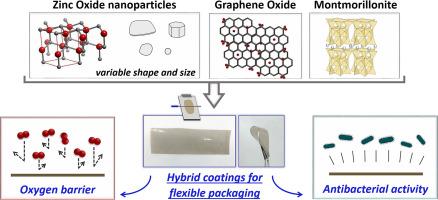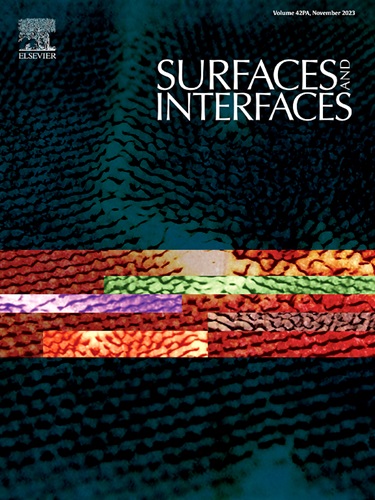The effect of ZnO nanoparticles morphology on the barrier and antibacterial properties of hybrid ZnO/graphene oxide/montmorillonite coatings for flexible packaging
IF 5.7
2区 材料科学
Q2 CHEMISTRY, PHYSICAL
引用次数: 0
Abstract
The need for eco-friendly packaging solutions is continuously increasing, with several materials being investigated to develop functional coatings able to contrast food degradation due to oxidation and bacterial growth. In this work, ZnO nanoparticles (NPs) with various morphology and size from spherical to hexagonal, dots-like and platelets-like shape, were synthesized. Hybrid coatings constituted by ZnO NPs, graphene oxide (GO) and montmorillonite (MMT) were applied onto flexible polyethylene (PE) in order to exploit the 2D nanomaterials self-assembly ability and gas barrier properties and to synergistically combine these functionalities with the antibacterial activity of ZnO. The effect of ZnO NPs morphology and the ZnO/GO/MMT relative content was explored to obtain nanostructured coatings with optimized functionality. Results evidence a correlation between oxygen permeability and microbial proliferation, allowing to reach 88 % of reduction of PE oxygen permeability and about 60 % inhibition towards Gram-positive (i.e. Weizmannia coagulans) and Gram-negative (i.e. Escherichia coli) microorganisms.

氧化锌纳米颗粒形态对用于软包装的氧化锌/氧化石墨烯/蒙脱石混合涂层的阻隔性和抗菌性的影响
人们对环保包装解决方案的需求与日俱增,目前正在研究几种材料,以开发能够与氧化和细菌生长引起的食品降解形成对比的功能性涂层。在这项研究中,我们合成了从球形到六角形、点状和板状等不同形态和尺寸的氧化锌纳米粒子(NPs)。将 ZnO NPs、氧化石墨烯(GO)和蒙脱石(MMT)构成的混合涂层涂覆在柔性聚乙烯(PE)上,以利用二维纳米材料的自组装能力和气体阻隔特性,并将这些功能与 ZnO 的抗菌活性协同结合。研究人员探讨了 ZnO NPs 形态和 ZnO/GO/MMT 相对含量的影响,以获得具有优化功能的纳米结构涂层。结果表明,透氧性与微生物增殖之间存在相关性,可使 PE 的透氧性降低 88%,对革兰氏阳性(即 Weizmannia coagulans)和革兰氏阴性(即 Escherichia coli)微生物的抑制率约为 60%。
本文章由计算机程序翻译,如有差异,请以英文原文为准。
求助全文
约1分钟内获得全文
求助全文
来源期刊

Surfaces and Interfaces
Chemistry-General Chemistry
CiteScore
8.50
自引率
6.50%
发文量
753
审稿时长
35 days
期刊介绍:
The aim of the journal is to provide a respectful outlet for ''sound science'' papers in all research areas on surfaces and interfaces. We define sound science papers as papers that describe new and well-executed research, but that do not necessarily provide brand new insights or are merely a description of research results.
Surfaces and Interfaces publishes research papers in all fields of surface science which may not always find the right home on first submission to our Elsevier sister journals (Applied Surface, Surface and Coatings Technology, Thin Solid Films)
 求助内容:
求助内容: 应助结果提醒方式:
应助结果提醒方式:


